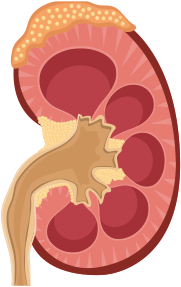Phosphorus: Tips for People with Chronic Kidney Disease
Phosphorus: Tips for People with Chronic Kidney Disease
What is phosphorus?
 Phosphorus is a mineral your body uses to store energy, help muscles contract, and support bone health. A normal phosphorus blood level for a healthy individual is 2.5-4.5 mg/dL. Depending on your stage of chronic kidney disease (CKD), you may need to reduce the phosphorus in your diet.
Phosphorus is a mineral your body uses to store energy, help muscles contract, and support bone health. A normal phosphorus blood level for a healthy individual is 2.5-4.5 mg/dL. Depending on your stage of chronic kidney disease (CKD), you may need to reduce the phosphorus in your diet.
Why is phosphorus intake important?
The kidneys are responsible for maintaining healthy levels of minerals like phosphorus in the blood. If you have CKD, phosphorus can build up in your blood, which over time can lead to:
- Itchy skin and bone and joint pain
- Calcium being pulled from your bones, weakening them
- Calcium deposits in your blood vessels and organs, a risk for heart attack or stroke
Share
View Handout [PDF – 674 KB]
Where is phosphorus found?
Phosphorus is naturally found in high-protein foods. About half of the phosphorus present in these foods is absorbed during digestion. Most people with CKD can eat these in moderation.
| Natural Phosphorus | ||||
|---|---|---|---|---|
| meat | fish | dairy | beans | nuts |
Phosphorus is added to many processed foods and drinks as a preservative. Your body absorbs nearly all of the added phosphorus in processed foods.
Foods with the highest amounts phosphorus are most often processed, packaged, and fast foods.
| Added Phosphorus | ||||
|---|---|---|---|---|
| baking mixes | cereals | cereal bars | sport drinks | |
| colas | chicken nuggets | lunch meat | processed cheese | |
How do I lower my phosphorus levels?
Portion control
- Eat smaller portions of foods high in protein.
- Choose plant-based foods more often since phosphorus is less easily absorbed from these.
Find hidden sources of phosphorus
Check the ingredients panel for the word “phosphorus” or words that contain “PHOS”.
INGREDIENTS: POTATOES, OIL (PARTIALLY HYDROGENATED SOY OIL), SALT, DEXTROSE, DISODIUM PHOSPHATE, PHOSPHORIC ACID.
Choose foods with less phosphorus
| Foods lower in phosphorus | Foods higher in phosphorus |
|---|---|
| Milk, soy, or rice beverage Yogurt, cottage cheese Cream cheese |
Processed cheese: American or commodity Natural cheese: Swiss, cheddar, and mozzarella |
| Fresh meat: chicken, turkey, beef, lamb, pork, and moose Legumes: Beans, lentils, tofu, and hummus Eggs |
Processed meat: hotdogs, bacon, ham, sausage, and pizza with meat Seafood: shellfish, salmon, sardines, cod, and tuna Organ meat: liver, kidney, and heart Wild game: venison, bison, and elk |
| Popcorn, rice cakes, and rice crispie bar | Nuts, seeds, and peanut butter, and chocolate |
| Fruits and vegetables | Vegetables prepared with sauces Packaged potatoes with "phos" ingredients |
| Fresh bread without "phos" ingredients, pita bread. Plain cereal: cornflakes, puffed rice, oatmeal. Corn meal and plain rice | Processed breads and cereals with "phos" additives. Baking and pancake mixes, biscuits, cakes, and wheat bran |
| Drinks: Fresh brewed coffee or tea, water, light colored soda, root beer, and apple, cranberry, and grape juice | Drinks: Bottled coffee, iced tea, dark sodas, beer and wine, hot cocoa, and energy and sports drinks |
Phosphate binders
 Your health care provider may prescribe phosphate binders, which are pills taken with meals to help lower the amount of phosphorus your body absorbs.
Your health care provider may prescribe phosphate binders, which are pills taken with meals to help lower the amount of phosphorus your body absorbs.




